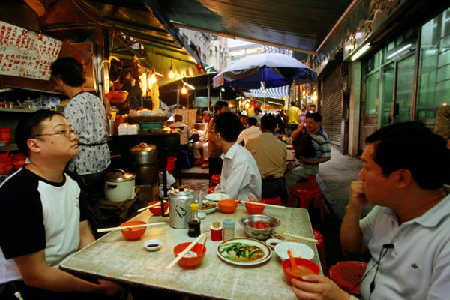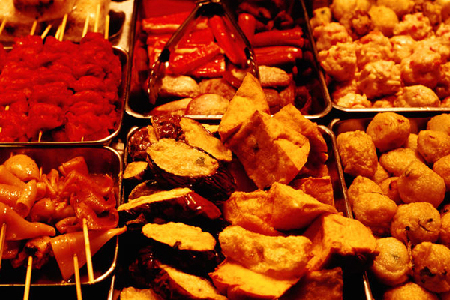Delicacies
One-of-a kind dining in Hong Kong
Updated: 2011-01-10 17:41
By Piera Chen (Lonely Planet)
Hong Kong's chefs are a versatile bunch who can move with ease between different culinary traditions, bringing together not only old and new, Chinese and Western, but haute and humble, coffee and tea. Their skills and creativity, and the city's love of food, have given rise to many one-of-a-kind dining experiences. Among the following only-in-Hong Kong selections, Tim Ho Wan, Bo Innovation, Olala and Tai Ping Koon come Michelin starred or recommended.
 |
Gourmet hawker Hong Kongers will eat absolutely anything as long as it justifies its place on a table, any table. So to avoid paying exorbitant rent and focus on the food instead, savvy restaurateurs have been hawking their dishes in government-run food courts, offering fine dining at unfashionably low prices. Among these gourmet hawkers, ABC Kitchen (Queen St Cooked Food Market, 38 Des Voeux Rd W) stands out for its authentic Western menu. Inside the frenzied, fluorescent-lit expanse which the eatery shares with other operators, ABC regulars slurp up bouillabaisse made with fresh local seafood, wolf down the crispiest cochinillo asado (roast sucking pig), and inhale fluffy souffle, all for the price of an entree served under crystal chandeliers.
Cheapest starred eatery Similarly, at the world's cheapest Michelin-starred restaurant, Tim Ho Wan (2-20 Kwong Wa St), layfolk get to sample food fit for emperors. Owner Mr Mak was a dim sum chef at three-starred Lung King Heen of the Four Seasons before going it alone. Now, cooped up inside his glorious hole, in a haggard part of town, he recreates his magic – the famed barbecued pork buns (char siu baau), over 750 of which are sold a day, beef balls infused with dried mandarin peel, fragrant osmanthus flower jelly – for anyone who can afford a US$1.50-$3 for a basket of dim sum and, crucially, who will wait the same number of hours. The lines at Tim Ho Wan are heart-stopping. When you arrive, a smiling Mrs Mak will hand you a number. Then go fly a kite, learn Cantonese opera, or plant some roses, and check back after 90 minutes.
 |
Chinese molecular gastronomy Foam and powder may not be everyone's comfort food, but molecular gastronomy does enjoy a following in Hong Kong. Bo Innovation, which deconstructs classic Chinese dishes and reassembles them in visually and gastronomically surprising ways, is among the few that impress. Xiao long bao (pork dumpling), for example, is a blob of ginger-infused pork soup encased in a transparent wrapper that explodes when consumed into the juiciest pork dumpling.
Jetsetting noodles Hong Kong's most expensive Shanghainese-style noodles (US$20 for a bowl) feature thick-cut strands of homemade noodles, and a broth boiled with handpicked Iberico ham, French rose shrimp, and all manner of European and Asian goodness. But before you dismiss them as OTT, consider this: their creator Mr Chow is a zealous Hong Kong chef of Shanghainese descent who's lived in France. Besides the noodle shop, he also owns a French restaurant and charcuterie nearby. So if history had flavours, Hong Kong's migrant and colonial heritage might taste something like the noodles at Olala (33 St Francis St).
Soy sauce Western 'Soy sauce Western' (si-yau sai-chaan) is the endearing name locals give to a style of cooking that features Western dishes prepared with (some say too much) Chinese wisdom. It's believed to have been invented by the sous chef of a foreign trading company in the Qing dynasty, and influenced by the shashlik, zakuska, and borscht of White Russians who had fled to Shanghai and opened cafes. Western recipes are liberally adapted, such as by replacing dairy ingredients with soy and Worcester sauce (Chinese were lacto-intolerant). Tai Ping Koon is known for its smoked pomfret, roast pigeon and turkey-sized souffle. At Queen's Cafe, the borscht and baked pork chop over rice are perennial favourites.
 |
Tea cafes Tea cafes (chaa chaan teng) appeared in the 1940s as cheap and cheery neigbourhood joints serving Western-style snacks and beverages to locals who couldn't afford scones and Earl Grey. Since then, their menus have evolved to include an embarrassment of quick-and-easy selections, Chinese and pseudo-Western. But they're best known for their 'pantyhose' milk tea – a strong and silky brew made from black tea and crushed egg shells. It's filtered through a bag that hangs like a stocking, hence the name, and consumed with evaporated milk. It's sometimes mixed with three parts coffee to create the popular drink ‘yin yeung' or tea-coffee. Pak Kung Cafe (91 Ma Tou Kok Rd) and Mido CafE (63 Temple St) serve a mean cup of ‘yin yeung’ amid nostalgic mid-century surrounds.
E-paper

Ear We Go
China and the world set to embrace the merciful, peaceful year of rabbit
Carrefour finds the going tough in China
Maid to Order
Striking the right balance
Specials

Mysteries written in blood
Historical records and Caucasian features of locals suggest link with Roman Empire.

Winning Charm
Coastal Yantai banks on little things that matter to grow

New rules to hit property market
The State Council launched a new round of measures to rein in property prices.
